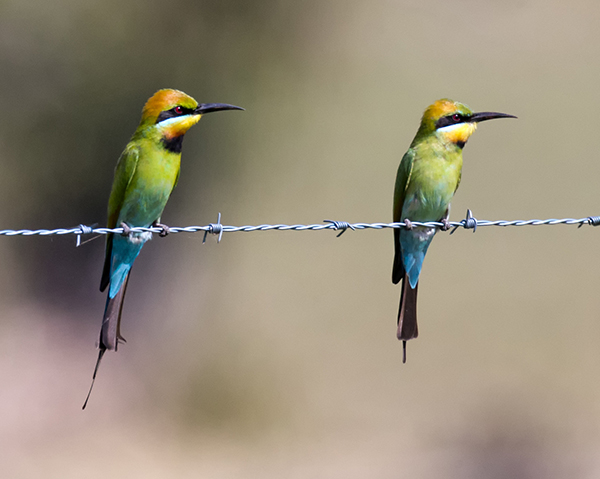The Rainbow Bee-eater is the only member of the bird family Meropidae to be found in Australia. It is a striking bird with green, blue, chestnut and yellow plumage. It is medium in size and has a long slim curved bill with distinctive tail streamers. 
Female Rainbow Bee-eater
Females have shorter, thicker tail streamers than males while young birds are duller and greener. Sometimes Rainbow Bee-eaters are confused with kingfishers, but kingfishers are plumper with strong, straight beaks and they never catch prey in flight. Rainbow Bee-eaters eat insects on the wing. They can be seen darting after insects as a flash of bright colour, twisting and turning and then grabbing the insect in its bill. The bee-eater then returns to its perch to eat the insect. They mainly catch bees, wasps, dragonflies, beetles, butterflies and moths. If they have caught a bee or a wasp, they rub them against the perch before eating them to remove stings.
The Rainbow Bee-eater is found throughout mainland Australia, as well as Indonesia and New Guinea. Sometimes it is found in the Solomon Islands. The Rainbow Bee-eater is found in many different habitats usually near water, including in open forests, woodlands and shrublands. Farmland remnant vegetation is important to the bird, and it can be found around orchards and vineyards. It will also use sites such as quarries, cuttings and mines to build its nesting tunnels.
In the spring, Rainbow Bee-eaters migrate from the north down to the south, and birdwatchers are often delighted to see the first bee-eaters darting about. They breed from November to January in the south. In the autumn, the southern birds migrate back to the warmer climes. However, there are populations in the north which remain year round and breed up. Both male and female birds will chose a suitable nesting site, usually in a sandy bank, and dig a long tunnel (on average 90cm long) with a grass-lined nesting chamber at the end. Both parents incubate the eggs and feed the young, sometimes with help from other members of the flock. The majority of the global population breeds in Australia.
Rainbow Bee-eaters are very social birds and when they are not breeding they roost together in large groups in dense undergrowth or large trees. Rainbow Bee-eaters have been found to live for up to 24 months in the wild. Processes that could impact on populations of Rainbow Bee-eaters include feral foxes.
You are here
Rainbow Bee-eater
Thursday 24th November

Posted in:
Healthy Environments
